An incredible painting comes to life – that’s Mt. Fuji in a nutshell! Japan’s highest peak is more than just a postcard view though – it’s a blending of nature and tradition.
Whether you want to take in the sights or challenge yourself with a rejuvenating hike, I’ll guide you through all you need to know when visiting this legendary mountain.
Also, remember to bring your iRoamly Japan travel eSIM to make sure you stay connected, even when you're in a remote area, so you can share every breathtaking moment instantly!
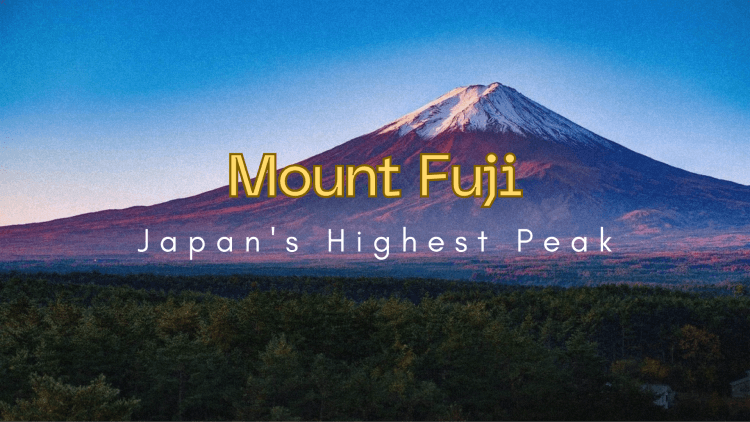
What is the highest mountain in Japan?
Sitting at the top spot is Mount Fuji – Japan’s highest mountain at 3,776 meters (12,389 feet). As beautiful and symmetric as a postcard, this iconic active volcano is also culturally and spiritually significant.
Sitting on Honshu Island, on a clear day Fuji can be seen all the way from Tokyo, and each year hundreds of thousands flock to its slopes. Its near-perfect cone, formed from its history of eruptions, has proven a beloved subject in art and photography, symbolizing beauty and strength in Japanese iconography. Just because it looks peaceful doesn’t mean it is, with its last major eruption in 1707.
Why is it called Mt. Fuji?
As for the name “Fuji”, it’s believed to originate from the Ainu language, where it means “everlasting life”. Impressive stuff, right? It’s a mountain rich with spiritual importance, with pilgrims visiting for centuries – it’s easy to find peace and serenity (no pun intended) at the shrines surrounding the base.
Best Spots to Enjoy the View
1. Lake Kawaguchi
Calm waters provide a mirror reflection of Mt. Fuji, surrounded by red and gold leaves in autumn and crisp snow in winter.
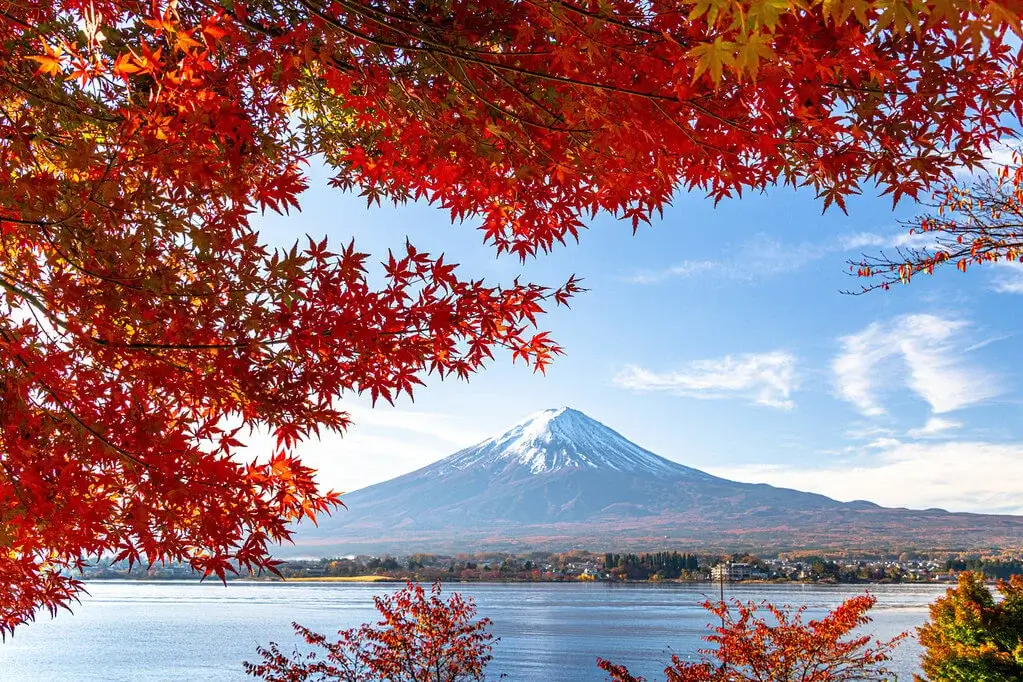
Location: Fujikawaguchiko, Yamanashi Prefecture.
Top tip: Time your visit for the best reflections in autumn, or head out early for a glassy surface. No entry fee.
2. Chureito Pagoda
The five-storey pagoda is a classic shot of Mt. Fuji, especially when flanked by cherry blossoms or fiery autumn leaves.
Location: Arakurayama Sengen Park, Fujiyoshida City.
Top tip: Climb up at sunrise for fewer tourists and beautiful lighting, though cherry blossom and autumn foliage viewing is particularly busy. Free to visit.
3. Oshino Hakkai
Eight crystal-clear ponds in an idyllic village setting make for a more rural Mt. Fuji experience, with traditional thatched buildings and verdant gardens completing the picture.
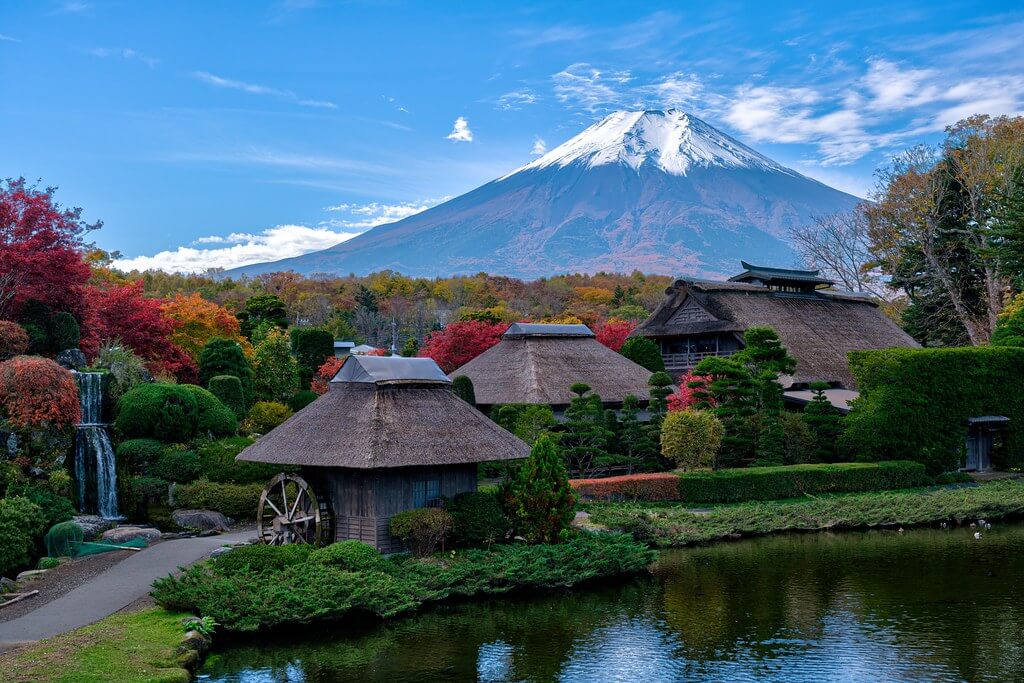
Location: Oshino, Yamanashi Prefecture.
Top tip: Take your time exploring the village, sampling local produce, and browsing for unique souvenirs from Japan in between soaking in the views. No entry fee.
4. Gotemba Premium Outlets
Shop at the foot of Mt. Fuji, where designer labels are set against the backdrop of the great mountain, visible from the spacious food court or numerous shops.
Location: Gotemba City, Shizuoka Prefecture.
Top tip: Best visited on a clear day for the best views, though the shopping and dining opportunities are plentiful too. It’s also a great spot to explore what you can buy in Japan while enjoying the scenery. No fee for the view.
5. Fuji Shibazakura Festival
The spectacular sight of pink, carpet-like shibazakura flowers meets Mt. Fuji’s gaze at this lively spring festival.
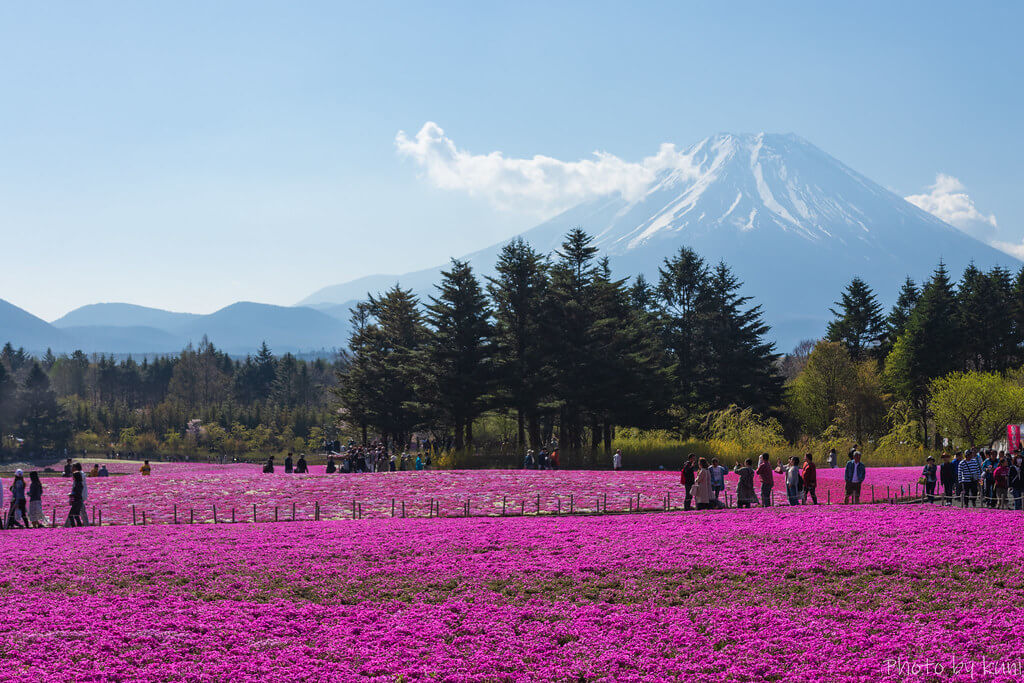
Location: Held at Fuji Motosuko Resort, near Lake Motosu.
Top tip: Time your visit for peak blooms, which usually run from mid-April to the end of May. Entry is charged for this annual event.
Five facts you need to know about Mt. Fuji
Wholely a composite volcano, it's the beautifully symmetrical volcanic cone that makes Mt. Fuji an iconic image of Japan. Here are a handful of specifics about the mountain.
Type: Stratovolcano, characterised by explosive eruptions and pyroclastic flows.
History: The base upon which Mt. Fuji is predominantly settled began forming some 10,000 years ago. The most recent layer built up in an eruption from Komitake, a lateral crater, in 1707, during the Edo period.
Gender Bar: Women were not permitted to climb Mount Fuji until 1868. In 1867, Fanny Parkes, a Welsh travel journalist, became the first woman to climb the mountain. The government lifted the ban in 1872.
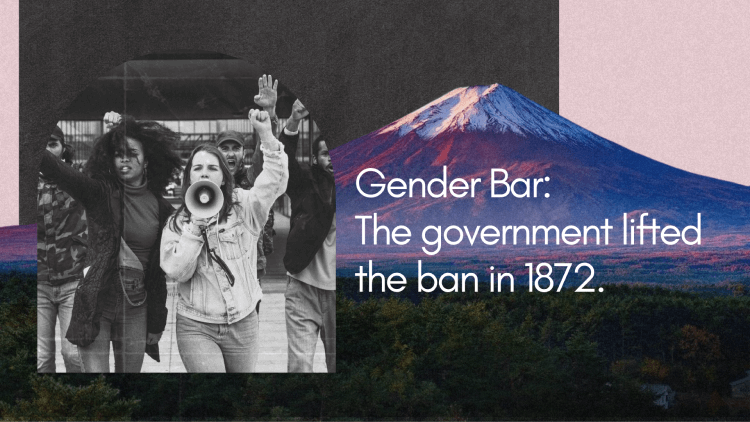
First Ascent: A monk is generally considered to have been the first person to scale the mountain, in 663 AD.
Climbing Season: The official climbing season is from early July to mid-September, when the weather is at its most stable and snowfall is lowest.
Climbing Mt. Fuji
What's it like up there?
Climbing Mt. Fuji is an experience of several environments as you ascend. From a forested base to approaching the lunar fields around the fifth station (Fujisan-gogome), the situation is changing. Vegetation becomes almost nonexistent, and the terrain is largely composed of volcanic rock and ash. Climbing becomes tougher the higher you get, physically and psychologically.
Above the fifth station, the environment becomes more challenging and inhospitable, with the air both thinner and colder. Conditions can be erratic, with sudden drops in temperature and gusty winds surprising the unwary or unprepared, even in the height of summer. Snow can linger on Mt. Fuji until August, and temperatures may drop below freezing, while local towns are balmy.
Mt. Fuji Hiking Course
Climbing the mountain is regarded as a pilgrimage, with dozens of known paths making the climb accessible to various skill levels. The following are the most common routes, scaling the mountain from different cardinal directions, offering different outlooks, and taking varying amounts of time:
1. Yoshida Trail
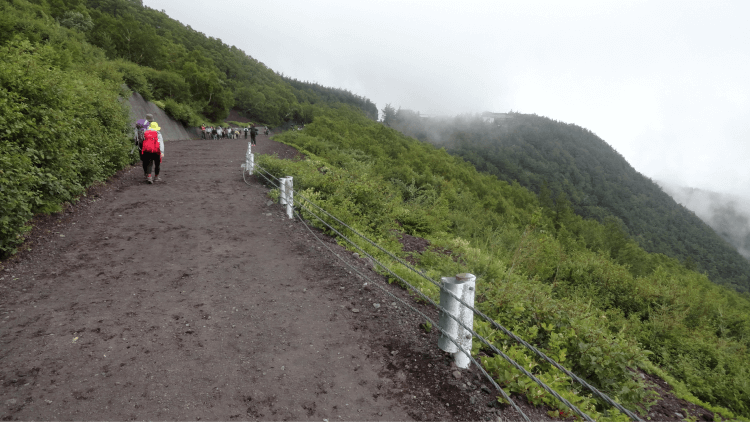
Starting Point: Fuji-Subaru Line 5th Station
Required Time: Approximately 6-8 hours to ascend, 3-5 hours to descend
Features: The most frequently traveled path, notable for the large number of huts along the way and the quality of the trails. Hikers gain a beautiful sunrise view and the option for night climbing, making this the most popular trail.
2. Subashiri Trail
Starting Point: Subashiri 5th Station
Required Time: About 6-8 hours to ascend, 3-5 hours to descend
Features: Merges with the Yoshida Trail at the 8th station. Offers a forested hike on approach, providing some shade and stunning foliage in the early season.
3. Gotemba Trail
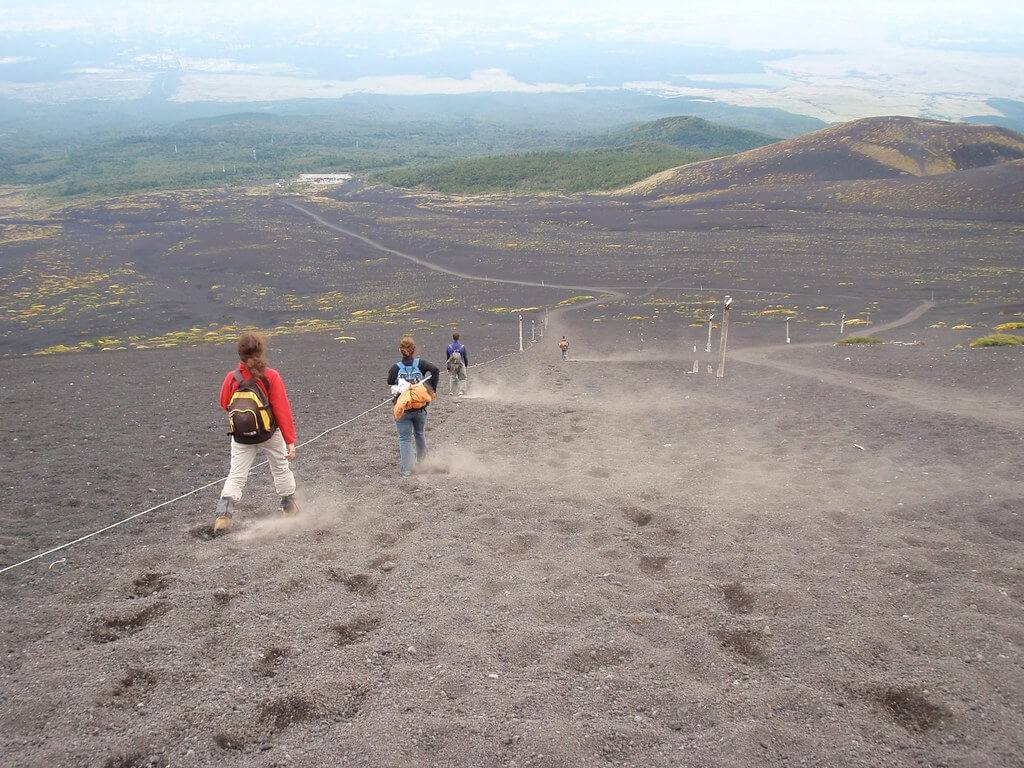
Starting Point: Gotemba 5th Station
Required Time: The longest path at 7-10 hours to ascend, 3-6 to return.
Characteristics: Starting from the lowest 5th station, the ash-covered trail is not maintained as the others, so can be loose underfoot. It requires a longer climb, but offers great views at the 9th station, from where you can also attempt a challenging hike to Hakusan from.
4. Fujinomiya Trail
Starting Point: Fujinomiya 5th Station
Required Time: Approximately 5-7 hours to ascend, 2-4 hours to descend
Features: The shortest, and steepest trail to the peak. The top third of the trail gives you a nice view of a sea of clouds below you. It also tends to have slightly fewer people, but is generally cleaner as a result.
Hiking tips
Taking a seasonal mountain hiking tour or climbing can be done by dressing for the walk, but however you’re planning to go, wear sturdy footwear, dress in layers (it’s going to get cold the nearer you get to the summit), and make sure you have plenty of water. A walking stick is useful for navigating the particularly taxing incline and loose rocks.
Getting to the summit can take around six hours, and another three to get back down, so start your trip early to avoid coming down in the dark.
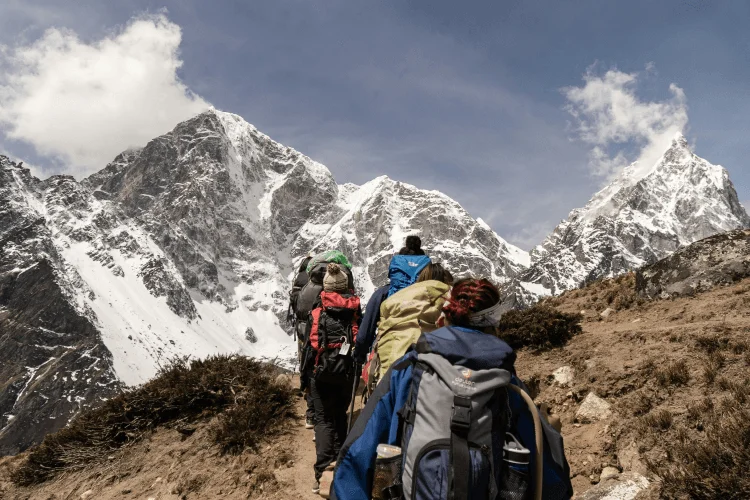
But also... try to remember that it’s not a race. Enjoy the view!
FAQ
1. Why is Mt. Fuji famous?
It’s that iconic shape and its overall cultural significance. Mt. Fuji has appeared in art and stories for hundreds of years.
2. Is Japan all mountains?
No, Japan is not all mountains, but it is predominantly mountainous.
3. Is Mt. Fuji an active volcano?
Yes. But it hasn’t erupted for more than 300 years.
4. When was Mt. Fuji’s last eruption?
In December 1707 during the Hoei eruption. This also created a new crater and second peak about halfway down the side.
Summary
A visit to Mt. Fuji is a visit to another world: a place of beauty, peace, and serenity. Whether you are there to snap the perfect picture, hike its trails, or simply immerse yourself in its presence, Mt. Fuji has something for everyone.
It’s more than a mountain; it is a symbol of natural wonder and a touchstone of Japanese heritage. So pack your bags – let’s go to Mt. Fuji!
